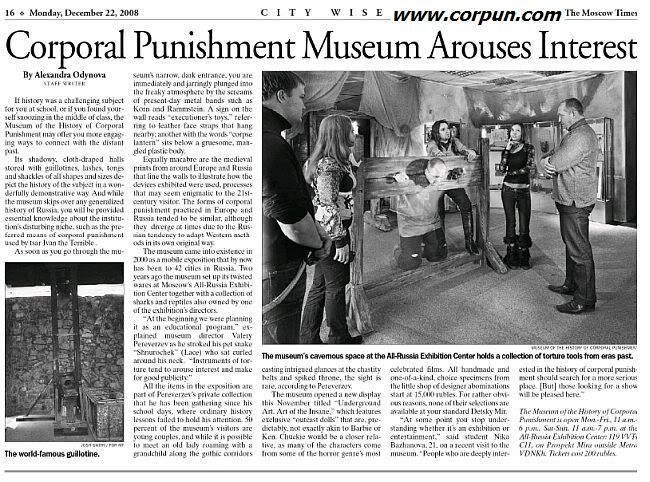Corpun file 20871 at www.corpun.com
The Moscow Times, 22 December 2008
Corporal Punishment Museum Arouses Interest
By Alexandra Odynova
Staff WriterIf history was a challenging subject for you at school, or if you found yourself snoozing in the middle of class, the Museum of the History of Corporal Punishment may offer you more engaging ways to connect with the distant past.
Its shadowy, cloth-draped halls stored with guillotines, lashes, tongs and shackles of all shapes and sizes depict the history of the subject in a wonderfully demonstrative way. And while the museum skips over any generalized history of Russia, you will be provided essential knowledge about the institution's disturbing niche, such as the preferred means of corporal punishment used by tsar Ivan the Terrible .
As soon as you go through the museum's narrow, dark entrance, you are immediately and jarringly plunged into the freaky atmosphere by the screams of present-day metal bands such as Korn and Rammstein. A sign on the wall reads "executioner's toys," referring to leather face straps that hang nearby; another with the words "corpse lantern" sits below a gruesome, mangled plastic body.
Equally macabre are the medieval prints from around Europe and Russia that line the walls to illustrate how the devices exhibited were used, processes that may seem enigmatic to the 21st century visitor. The forms of corporal punishment practiced in Europe and Russia tended to be similar, although they diverge at times due to the Russian tendency to adapt Western methods in its own original way.
The museum came into existence in 2000 as a mobile exposition that by now has been to 42 cities in Russia. Two years ago the museum set up its twisted wares at Moscow's All-Russia Exhibition Center together with a collection of sharks and reptiles also owned by one of the exhibition's directors.
"At the beginning we were planning it as an educational program," explained museum director Valery Pereverzev as he stroked his pet snake "Shnurochek" (Lace) who sat curled around his neck. "Instruments of torture tend to arouse interest and make for good publicity."
All the items in the exposition are part of Pereverzev's private collection that he has been gathering since his school days, where ordinary history lessons failed to hold his attention. 50 percent of the museum's visitors are young couples, and while it is possible to meet an old lady roaming with a grandchild along the gothic corridors casting intrigued glances at the chastity belts and spiked throne, the sight is rare, according to Pereverzev.
The museum opened a new display this November titled "Underground Art. Art of the Insane," which features exclusive "outcast dolls" that are, predictably, not exactly akin to Barbie or Ken. Chuckie would be a closer relative, as many of the characters come from some of the horror genre's most celebrated films. All handmade and one-of-a-kind, choice specimens from the little shop of designer abominations start at 15,000 rubles. For rather obvious reasons, none of their selections are available at your standard Detsky Mir.
"At some point you stop understanding whether it's an exhibition or entertainment," said student Nika Bazhanova, 21, on a recent visit to the museum. "People who are deeply interested in the history of corporal punishment should search for a more serious place. [But] those looking for a show will be pleased here."
The Museum of the History of Corporal Punishment is open Mon.-Fri., 11 a.m.-6 p.m., Sat-Sun. 11 a.m.-7 p.m. at the All-Russia Exhibition Center: 119 VVTs C11, on Prospekt Mira outside Metro VDNKh. Tickets cost 200 rubles.
About this website
Search this site
Video clips
Picture index

